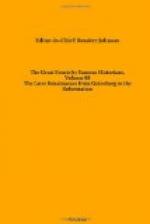The ships continued running along the coast close to land, for the coast was clear, without banks against which to take precautions; and the pilots gave orders to cast anchor in a place which made a sort of bay, because there commenced the city of Calicut. This town is named Capocate, and on anchoring there a multitude of people flocked to the beach, all dark and naked, only covered with cloths half way down the thigh, with which they concealed their nakedness. All were much amazed at seeing what they had never before seen. When news was taken to the King he also came to look at the ships, for all the wonder was at seeing so many ropes and so many sails, and because the ships arrived when the sun was almost set; and at night they lowered out the boats, and Vasco da Gama went at once for his brother and Nicolas Coelho, and they remained together conversing upon the method of dealing with this King, since here was the principal end which they had come to seek; it seemed to him that it would be best to comport himself as an ambassador, and to make him his present, always saying that they had been separated from another fleet which they came to seek for there, and that the captain-major had come and brought him letters from the King.
This they agreed upon together, and that Vasco da Gama should go on shore with that message sent by the captain-major, who carried the standard at the peak; they also talked of the manner in which these things were to be spoken of. When all was well decided upon, Nicolas Coelho returned to the ship, and Vasco da Gama remained with his brother talking with the Moor Taibo (the broker), who told him not to go on shore without hostages; that such was the custom of men who newly arrived at the country; and the Moor said that this King of Calicut was the greatest king of all the coast of India, and on that account was very vain, and he was very rich from the great trade he had in this city.
[Footnote 1: Translated from the Portuguese by Henry E. J. Stanley.]
[Footnote 2: Herodotus tells us that Phoenicians rounded this cape as early as B.C. 605.]
COLUMBUS DISCOVERS SOUTH AMERICA
A.D. 1498
CLEMENTS ROBERT MARKHAM
On September 25, 1493, Columbus sailed from Palos and began his second voyage of discovery. He had seventeen vessels and about fifteen hundred men. In November he discovered Dominica in the West Indies. Arriving at La Navidad, Espanola (Haiti), he found that the colony which he had left there on returning from his first visit had been killed by the Indians. At a point farther east he founded Isabella, the first European town in the New World.
In April, 1594, he, sailed westward and along the south shore of Cuba, which he mistook for a peninsula of Asia. He next discovered Jamaica, and in September returned to Isabella. The Indians rose in rebellion against the Spaniards, who had ill-used them, and Columbus quelled the insurrection, in a battle on the Vega Real, April 25, 1495. He had before planned for the enslavement of hostile Indians, an act from which his reputation has somewhat suffered.




